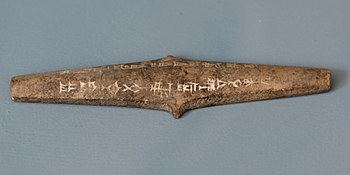| Kuri-Galzu II | |
|---|---|
| King of Babylon | |
 Dagger of king Kurigalzu II, Istanbul Archaeological Museum | |
| Reign | 25 regnal years 1332–1308 BC |
| Predecessor | Burna-Buriaš II Kara-ḫardaš Nazi-Bugaš |
| Successor | Nazi-Maruttaš |
| House | Kassite |
Kurigalzu II (c. 1332–1308 BC short chronology) was the 22nd king of the Kassite or 3rd dynasty that ruled over Babylon. In more than twelve inscriptions, Kurigalzu names Burna-Buriaš II as his father. Kurigalzu II was placed on the Kassite throne by the Assyrian king Aššur-Uballiṭ I, reigned during a period of weakness and instability for twenty five years, eventually turning on his former allies and quite possibly defeating them at the battle of Sugagu. He was once thought to have been the conqueror of the Elamites but this now tends to be assigned to the earlier king of this name, together with the Chronicle P account.[1]
There is a gap of a little over forty years between his reign and that of his earlier namesake, Kurigalzu I and, as it was not customary to assign regnal year numbers, and they both had lengthy reigns, this makes it exceptionally difficult to distinguish for whom an inscription is intended.[2] A few royal inscriptions are clearly assignable to Kurigalzu II since they give the name of his father, Burna-Buriaš, but these record either the dedication of objects, such as eye stones, beads, axe-heads, etc., or appear on the cylinder seals of his servants, such as the accountant, Uballissu-Marduk. 167 economic texts, mostly from Nippur, are assigned to him based on the style of the date formula and record up to the 24th year of his reign.[2] An inscribed brick of Kurigalzu II was found at Dur-Kurigalzu.[3]
- ^ F. Vallat (2000). "L'hommage de l'élamite Untash-Napirisha au Cassite Burnaburiash". Akkadica (114–115): 109–117.
- ^ a b J. A. Brinkman (1976). "Kurigalzu". Materials for the Study of Kassite History, Vol. I (MSKH I). Oriental Institute of the University of Chicago. pp. 205–246. especially pages 205 - 207.
- ^ Walker, C. B. F. “A Duplicate Brick of Kurigalzu II.” Journal of Cuneiform Studies, vol. 32, no. 4, 1980, pp. 247–48